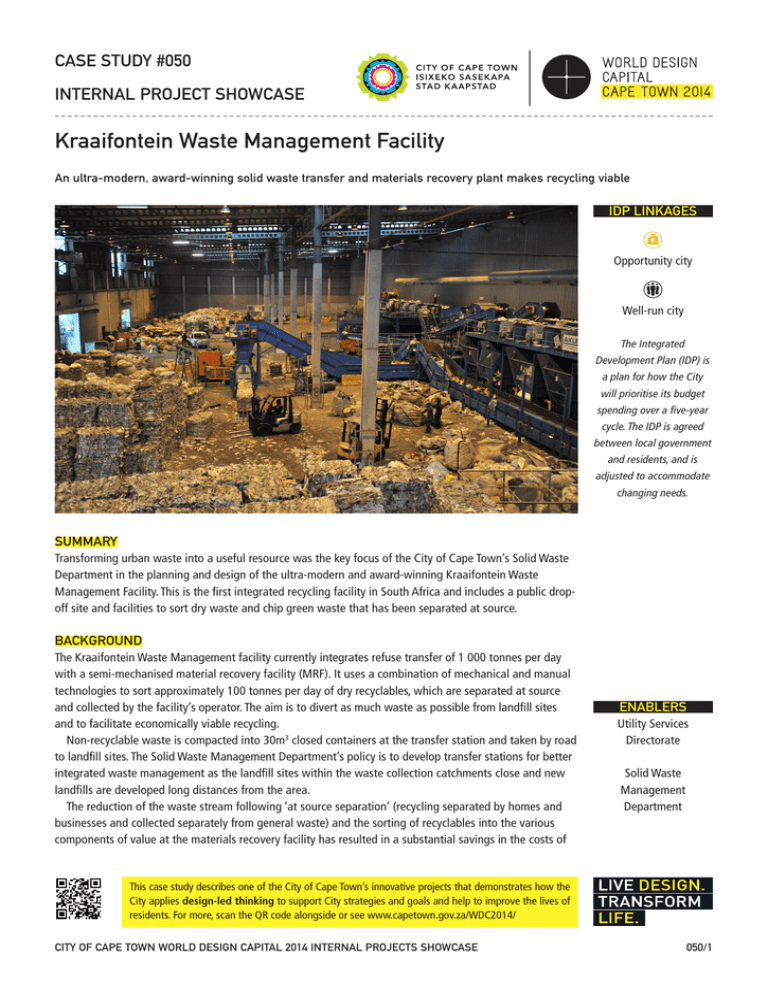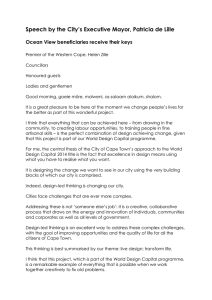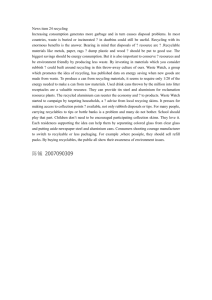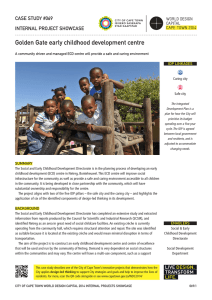Kraaifontein Waste Management Facility CASE STUDY #050 INTERNAL PROJECT SHOWCASE
advertisement

CASE STUDY #050 INTERNAL PROJECT SHOWCASE Kraaifontein Waste Management Facility An ultra-modern, award-winning solid waste transfer and materials recovery plant makes recycling viable IDP LINKAGES Opportunity city Well-run city The Integrated Development Plan (IDP) is a plan for how the City will prioritise its budget spending over a five-year cycle. The IDP is agreed between local government and residents, and is adjusted to accommodate changing needs. SUMMARY Transforming urban waste into a useful resource was the key focus of the City of Cape Town’s Solid Waste Department in the planning and design of the ultra-modern and award-winning Kraaifontein Waste Management Facility. This is the first integrated recycling facility in South Africa and includes a public dropoff site and facilities to sort dry waste and chip green waste that has been separated at source. BACKGROUND The Kraaifontein Waste Management facility currently integrates refuse transfer of 1 000 tonnes per day with a semi-mechanised material recovery facility (MRF). It uses a combination of mechanical and manual technologies to sort approximately 100 tonnes per day of dry recyclables, which are separated at source and collected by the facility’s operator. The aim is to divert as much waste as possible from landfill sites and to facilitate economically viable recycling. Non-recyclable waste is compacted into 30m3 closed containers at the transfer station and taken by road to landfill sites. The Solid Waste Management Department’s policy is to develop transfer stations for better integrated waste management as the landfill sites within the waste collection catchments close and new landfills are developed long distances from the area. The reduction of the waste stream following ‘at source separation’ (recycling separated by homes and businesses and collected separately from general waste) and the sorting of recyclables into the various components of value at the materials recovery facility has resulted in a substantial savings in the costs of ENABLERS Utility Services Directorate Solid Waste Management Department This case study describes one of the City of Cape Town’s innovative projects that demonstrates how the City applies design-led thinking to support City strategies and goals and help to improve the lives of residents. For more, scan the QR code alongside or see www.capetown.gov.za/WDC2014/ CITY OF CAPE TOWN WORLD DESIGN CAPITAL 2014 INTERNAL PROJECTS SHOWCASE 050/1 #050: KRAAIFONTEIN WASTE MANAGEMENT FACILITY transporting waste to landfill sites. Diverting waste from landfills also increases the lifespan of the City’s remaining landfill sites, which are fast becoming full. Stakeholders in this initiative include the Solid Waste Management Department, the middle to upper income areas from the Northern Suburbs (via the Think Twice recycling programme), high school learners and students from tertiary institutions, private contractors managing and operating the facility, and the local community. The need for a facility in the vicinity was identified in 2000, due to the closure of the Brackenfell and Faure landfill sites which had served the area previously. The R230 million multi-purpose facility is the first large-scale ‘greenfield’ integrated waste management facility in South Africa that integrates waste transfer with mechanised and manual sorting material recovery, chips garden waste for making compost, and includes a public drop-off facility for the convenience of the local communities, further promoting waste recycling. Construction and commissioning of the facility took place between 2008 and 2010 and its design included ‘green building’ features, making it a milestone achievement for waste management in South Africa. The facility won joint first prize (shared with the Koeberg interchange) for technical excellence in the 2012 South African Institution of Civil Engineering (SAICE) national awards. DESIGN THINKING Design-led thinking is a collaborative and usercentric process through which challenges are identified and creatively addressed to deliver innovative and relevant solutions. With the responsibilities placed on a city administration, the core driver for embracing INTEGRATED DEVELOPMENT PLAN LINKAGES OPPORTUNITY CITY: The new facility provided employment for local residents during the construction phase and up to 30 locals are employed on a permanent basis by the City to operate the transfer station. About 170 additional jobs have been created to operate the materials recovery facility while 40 jobs have been created for the collection of the ‘at source’ separated dry recyclables. The material recovery facility operations and the transfer of waste containers by truck and trailer have been outsourced to private contractors. WELL-RUN CITY: By extracting components of value and reducing waste sent to landfills, the City is reducing the environmental impact of solid waste and offsetting the cost of waste management and disposal. The facility also makes it viable to promote a culture of recycling among residents, which has very long term sustainability benefits. design-led thinking is the improvement of the quality of life of citizens, the ethos that underpins the World Design Capital programme. DESIGN TOOLS For an explanation of the HOW HAS DESIGN BEEN USED? Of the key tools which support design-led thinking in project conception, creation and implementation, the following are fundamental to the success of this project: + DREAM TEAM: Prior to the Kraaifontein Waste Management Facility's design and construction, the project manager of Solid Waste Management’s Disposal Branch and the consultant’s project director met with a very wide range of people to obtain information and refine the design. Communication channels included regular project meetings, personal meetings, technical visits to sites overseas, discussions with contractors in the field and regular meetings with City departments involved with the project. + EVOLUTIONARY APPROACH: Although this was a large project it was completed in just over three years. Once the concept design had been finalised and appropriate technology had been selected, detailed design proceeded with considerable input from architects, and structural and mechanical engineers. Tenders were invited and the facility was built in approximately 22 months. Now that it is in operation, small changes are being implemented to fine-tune areas of concern and to improve service delivery. This will be an ongoing process. + QUICK DELIVERY: Once the need for a materials recovery facility, refuse transfer station, public dropoff facility and garden chipping facility for the area was identified, the facility was researched, and the design and construction was fast-tracked. + OPEN ACCESS TO INFORMATION: The Solid Waste Management Disposal Branch is continually engaged in the planning of material recovery facilities, refuse transfer stations and public drop-off facilities. All previous reports, experience and knowledge is thus well entrenched, and the team has CITY OF CAPE TOWN WORLD DESIGN CAPITAL 2014 INTERNAL PROJECTS SHOWCASE key constructs which support design-led thinking in project conception, design and implementation,see the Toolbox. 050/2 #050: KRAAIFONTEIN WASTE MANAGEMENT FACILITY now managed the design and development of three large transfer stations/integrated waste management facilities. A fourth, in Bellville, is currently under construction. + INNOVATION CHAMPS: The facility benefitted from having dedicated project managers and consulting engineers who were all committed to this project and ensured its success through input from people with a varied range of skills. + BIG THINKING, LOCALISED IMPACT: The establishment of a clean materials recovery facility in conjunction with the more common refuse transfer station, drop-off and chipping area was completely new to Cape Town and could have been considered a risky enterprise. The project team, however, saw it as an opportunity to instil and demonstrate the value of recycling and the financial viability for contractors involved. It sets the bar high, and offers lessons learnt for future developments at other waste disposal facilities. + COMMUNITY AT THE CENTRE, CREATIVITY ON THE FRINGE: The Solid Waste Management Department continually promotes waste minimisation and environmental awareness, for the general and environmental health of all Capetonians and future generations. The need for recycling is increasingly being accepted by the public at large, which made the decision to develop a materials recovery facility that much easier. DESIGN THINKING Design-led thinking is a collaborative and usercentric process through which challenges are identified and creatively addressed to deliver innovative and relevant solutions. With the responsibilities placed on a city administration, the core driver for embracing FURTHER INFORMATION Contact Colin Hall: colin.hall@capetown.gov.za design-led thinking is the improvement of the quality of life of citizens, the ethos that underpins the World Design Capital programme. DESIGN TOOLS For an explanation of the key constructs which support design-led thinking in project conception, design and implementation,see the Toolbox. CITY OF CAPE TOWN WORLD DESIGN CAPITAL 2014 INTERNAL PROJECTS SHOWCASE 050/3








